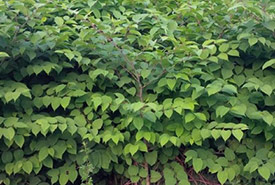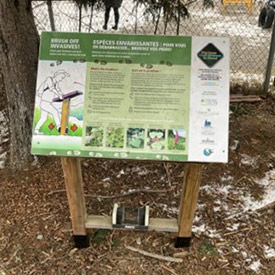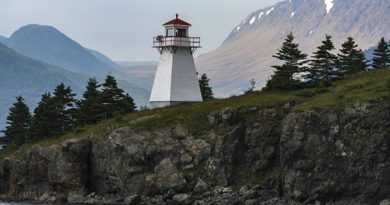NCC: Land Lines – The challenge of invasive species control

Japanese knotweed (Photo by Paula Noel/NCC staff)
I’ve spent my summer vacations along the Wolastoq River in New Brunswick since the late 90s. The riverbanks hosted a variety of native plants and animals typical for this area, including various grasses and sedges, maples and even poison ivy. However, about 15 years ago, I noticed the diversity I was accustomed to seeing had been replaced by an aggressive, invasive species: Japanese knotweed. It had filled the banks of a little creek that feeds into the Wolastoq River. This single species was spreading out of control in this important habitat type.
To halt or reverse biodiversity and ecosystem loss, the Kunming-Montreal Global Biodiversity Framework (GBF) identified 23 action-oriented targets for urgent action by 2030. Target 6 of the GBF aims to “reduce the introduction of invasive species by 50 per cent and minimize their impact.” Recognizing the threat of invasive species to our natural areas, the Nature Conservancy of Canada (NCC) has worked with Canadian Council on Invasive Species (CCIS) and provincial invasive species councils to protect Canada from the impacts of invasive species.
How does NCC manage invasive species?
Like CCIS, NCC takes a multi-pronged approach to managing invasives species and stopping the problems before they start. This includes applying strategic restoration guidance and partnering with researchers to understand the spread of invasives. To ensure NCC’s efforts are effective at the landscape-scale and contribute toward resilient landscapes, we identify the places where invasive species management has the greatest benefit.

At places like the Lincoln Wetland site near Fredericton, New Brunswick, NCC installed boot brushes, an effective way of removing potential invasive plant seeds, for visitors before they hit the trail and before they leave the site. (Photo Jennifer White/NCC staff)
It all begins with stopping the spread of invasives dead in their tracks. Using guidance from organizations like CCIS, NCC employs field protocols that eliminate or reduce the possible pathways of invasive species’ spread and establishment.
If invasive species have already established themselves in habitats, NCC and its partners may use different management techniques to reduce or eradicate invasives in priority areas to support healthy ecosystems. Phragmites control in Ontario is one of the best examples of what joint efforts from conservation organizations, land trusts, governments and funding partners can achieve. In the past seven years, NCC and its partners effectively managed 2,200 hectares of phragmites at Long Point, an internationally recognized 6,000-hectare coastal wetland complex along the shores of Lake Erie. The area had become heavily invaded by phragmites, threatening species at risk, migratory wildlife as well as recreational and economic activities.
The incredible success of this eradication program provided a working model of what landscape-scale collaborative conservation looks like and led to the development of a provincial strategy for phragmites management in Ontario led by the Ministry of Natural Resources, NCC and the Invasive Species Centre.
What changes are needed to overcome challenges?
While there are many great success stories of successful removal of invasives (with biocontrols, increased measures to prevent spread, partner collaborations), the challenge lies in ensuring invasive species management is occurring in the places where it will have the greatest impact on landscape resilience (i.e. being strategic where we spend limited resources). This includes using planning tools to help us identify target areas.
In dealing with invasive species, the emphasis should be on strong, healthy landscapes and, where possible, the prevention of their spread and establishment. Once established, removal becomes more expensive and may require repeated visits to the area to achieve success. Once invasive species are established, we have to use guidance such as recognized best management practices and evidence (all ways of knowing) to determine when invasive species removal is needed or the best option to support resilient landscapes.
Also, the development of effective invasive species management mechanisms is still lagging; we need external research to inform most effective methods to prevent and/or control invasive species. While there are still gaps in information, the IPBES report includes resources for policymakers and practitioners with some tools and targeted actions to deal with invasive species.
Furthermore, as invasive species management is closely tied to the restoration of a landscape, we still need to better measure the impact of management actions and restoration efforts. Beyond measuring success by the size of the area managed, it’s also about evaluating the effectiveness of prevention and restoration efforts, and collaborating with partners on priority actions.
To halt further spread of invasive species across all land bases, additional resources are needed to support the compliance and enforcement of existing regulations to prevent the spread of invasives.
What can we learn from others in this space, in Canada or around the world?
Something that we continuously reflect on is how effective prevention and eradication of invasive species can be advanced through respectful engagement with Indigenous Knowledge, perspectives and management approaches. The participation of Indigenous Peoples must be supported at decision-making tables regarding legislation and response plans. Solutions must include Indigenous governments (as rights holders) and reflect engagement with other groups (e.g. NGOs and industry), which are key to implementing effective invasive species management to better support a whole-of-society approach.
We all have a role to play
At the end of the day, one fact remains: the most effective and economical way to manage invasives is prevention.
We all play a part in preventing the spread, or establishment, of invasive species. NCC remains committed to the pragmatic control of invasive species, using the best available information to balance our approach. We’d love to hear from you. What strategies are you using to manage invasive species?
Follow us on LinkedIn and join the conversation!
Resources:
Global information about invasive species >
How will the GBF measure progress on targets >
Resources about invasive species management >
Why multi-species and spatially explicit management is important >




